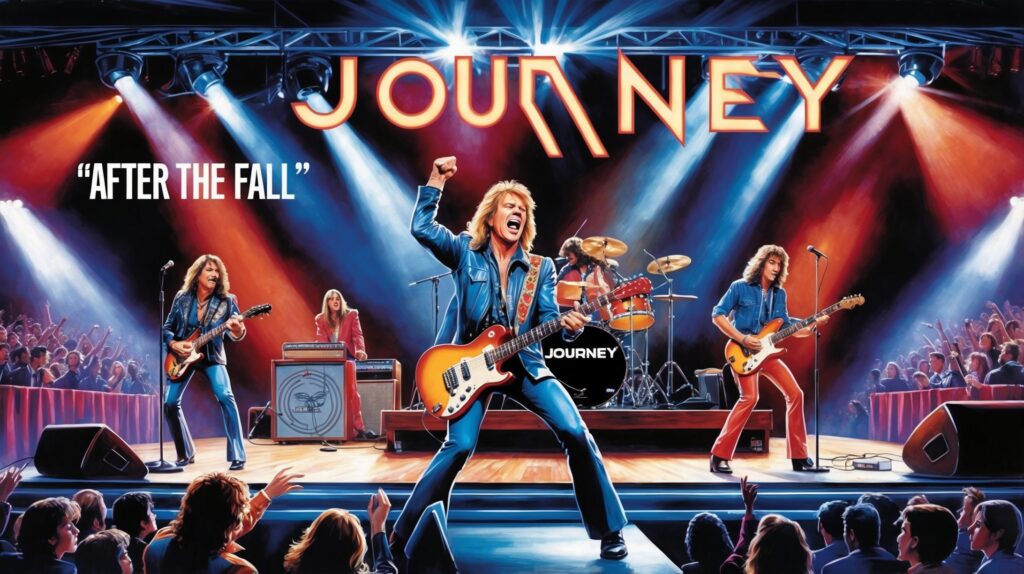Journey: A Musical Voyage Through Time
Journey rose to fame with their signature sound in the late 1970s and early 1980s. ‘After the Fall’ symbolizes a creative peak during a transformative era for the band, as they blended rock and emotional storytelling, establishing a timeless legacy.

Journey, the rock band synonymous with the 1980s arena sound, has etched its place in music history with a legacy of hits. Emerging in the early 1970s with a sound that fused rock and jazz, Journey underwent significant evolution over the years. At the time of releasing ‘After the Fall’, the band was riding the wave of immense popularity, largely due to their landmark album, ‘Escape’. The song reinforced Journey’s knack for creating potent melodies that linger in the listener’s mind.
The band was originally formed in San Francisco in 1973, featuring former members of Santana and Frumious Bandersnatch. The classic lineup during the ‘After the Fall’ era included Steve Perry on vocals, Neal Schon on guitar, Jonathan Cain on keyboards, Ross Valory on bass, and Steve Smith on drums. This ensemble is often credited with crafting some of the band’s most enduring hits, capturing the essence of rock and roll with each release.
The early 1980s were a significant time for Journey, marked by a period of creative exploration and commercial success. This era saw Steve Perry’s soulful voice and Neal Schon’s guitar prowess solidifying their place in rock history. Together, they cultivated a sound that was both innovative and rooted in the classic rock tradition. Their collaboration in this period produced a string of hits, helping ensure Journey’s lasting impact on the music scene.
Discovering Journey’s Musical Architect: Jonathan Cain
Dive into the intricate role of Jonathan Cain, Journey’s keyboardist and composer, in shaping ‘After the Fall’, merging rock and emotive melodies to craft this iconic track.

Jonathan Cain, primarily recognized as the keyboardist for the legendary rock band Journey, plays an instrumental role in the composition of ‘After the Fall.’ Born as Jonathan Leonard Friga in 1950 in Chicago, Illinois, Cain’s passionate affinity for music was evident from a young age. His journey began with rigorous musical training in piano, which paved the way for his illustrious career. Before joining Journey, he was a vital part of The Babys and later became a significant force in shaping Journey’s sound.
Cain’s musical style is an amalgamation of rock, pop, and a touch of classical influence, making him a versatile artist with a knack for creating melodic rock anthems. His ability to blend catchy pop melodies with driving rock rhythms became a signature element of Journey’s massive appeal in the 1980s. His influences span a diverse range, from classical pianists to rock icons, and this eclectic mix is reflected in his compositions.
Collaboration is at the heart of Cain’s work, notably his long-standing partnership with Journey’s lead vocalist, Steve Perry. Together, they crafted many of Journey’s timeless hits. In ‘After the Fall,’ Cain’s composition seamlessly intertwines with Perry’s soulful lyrics and voice, delivering a poignant and powerful musical narrative. Cain’s use of emotive piano lines lays the foundation for the song’s introspective and melodic essence, ultimately contributing to its success.
Jonathan Cain’s role in the creation of ‘After the Fall’ was pivotal. His innovative approach and musical acumen provided the song with a unique mood that resonated with listeners. By integrating layers of intricate keyboard harmonies with rock-solid arrangements, Cain captured the essence of emotional vulnerability, which is at the heart of the song’s lyrics. His composition became a canvas on which the interplay between the music and lyrics painted a vivid emotional picture.
The impact of Cain’s work on ‘After the Fall’ was significant, drawing positive reception from both critics and fans. His ability to translate introspective themes into compelling music highlighted his artistry and contributed greatly to the track’s success on the charts. Comparing ‘After the Fall’ to Cain’s other works within Journey’s discography, it’s evident that his compositional style consistently elevates the emotional depth and musical richness of the band’s repertoire.
Critically acclaimed for his songwriting prowess, Cain’s contributions to Journey extended beyond ‘After the Fall.’ His legacy in the music industry is marked by an enduring influence, evident in his ability to craft songs that are both timeless and impactful. Cain’s reflections on his work express a sense of fulfillment and pride, underscoring his passion for creating music that resonates with audiences across generations.
A Journey of Distinction: Covers and Cultural Impact
While ‘After the Fall’ by Journey did not win awards, it has been covered by various artists and featured in numerous media, underscoring its enduring impact.

When one talks about ‘After the Fall’ by Journey, it’s important to note that while the song didn’t clinch any notable awards on its own, it’s a significant piece in Journey’s comprehensive portfolio, enhancing their legacy in rock history. Released as part of their ‘Frontiers’ album in 1983, the song resonated deeply with fans, contributing to the band’s sustained popularity during the ’80s—a decade during which Journey became a defining voice in rock music.
The success of ‘After the Fall’ can be gauged not just by its reception among fans, but also by its numerous covers by various artists over the years. Though not as extensively covered as some of Journey’s biggest hits like ‘Don’t Stop Believin’,’ this track still garnered interest from emerging bands and artists who were inspired by its themes and melody, each bringing their unique interpretation to the song. Such covers serve as a testament to the song’s enduring power and influence.
Beyond the realm of audio, ‘After the Fall’ has appeared on various platforms, integrating into the soundtrack of TV shows and movies, subtly shaping its reputation as a beloved classic. Whether offering dramatic undertones in a film or enriching the emotional backdrop of a TV scene, the song’s frequent utilization in visual media has further amplified its cultural resonance.
Rising Up the Charts: The Journey of “After the Fall”
Explore the chart journey of Journey’s “After the Fall,” its place in the band’s storied career, and the marketing dynamics that boosted its visibility in the early ’80s rock scene.

“After the Fall” by Journey made its debut in the music world during the early ’80s, a time characterized by the flourishing of rock anthems and catchy melodies. Released in 1983 as part of their album Frontiers, this track managed to carve a significant niche in the band’s discography. Upon its release, “After the Fall” charted well, securing a respectable position on the Billboard Hot 100, where it peaked at number 23. While it might not have soared to the very top, it was a solid performer that contributed to solidifying Journey’s status as a rock powerhouse.
Comparing its chart performance to other Journey hits from the era, such as the iconic “Don’t Stop Believin'” or “Separate Ways (Worlds Apart),” “After the Fall” didn’t achieve the same commercial heights. However, it stood out for its emotional depth and the band’s signature sound, earning a loyal fan base that appreciated its subtle power. For Journey, a band already well-established by the early ’80s, this song represented a continuation of their successful journey rather than a breakthrough hit.
The track was supported by efficient marketing strategies that reinforced Journey’s presence on rock radio and in music video rotations, further enhancing its reach. Critics and fans alike recognized the song for its compelling lyrics and dynamic arrangement, often considering it a hidden gem within the Frontiers album. Over the years, “After the Fall” has remained a beloved track among Journey enthusiasts, contributing to the band’s enduring legacy. Its presence on streaming platforms today continues to introduce new generations to the timeless allure of Journey’s music.
Exploring Visual Dimensions: The Music Video for ‘After the Fall’
Though Journey’s ‘After the Fall’ lacks an official music video, fan-made tributes and live concert videos highlight its emotional depth and energy.

Though ‘After the Fall’ by Journey doesn’t have an official music video in the traditional sense, its legacy endures through numerous fan-made tributes, live performance videos, and impactful appearances in nostalgic compilations. Fan videos have played a pivotal role in extending the song’s reach and connecting it with new audiences. These videos, often laden with montages of concert footage, dramatic lyrical interpretations, or personal fan narratives, not only honor the song’s themes of love and resilience but also offer visually creative interpretations of its emotional depth.
Live recordings of ‘After the Fall’ showcase Journey’s quintessential stage presence and vivacious energy, capturing the band’s essence as a live performing act. Often shot during their tours, these videos reveal the band’s commitment to bringing the emotive power of their studio recordings to life on stage, mesmerizing audiences with both sound and sight. The stage lights, the crowd’s enthusiasm, and the palpable synergy between band members and fans create a vibrant tapestry that complements the song’s ethos.
While the absence of a dedicated music video might seem like a limitation, it offers a canvas for creativity among fans and fellow artists. This allows ‘After the Fall’ to thrive across different visual mediums, contributing significantly to its popularity. The song’s presence in various visual formats underscores the eclectic appeal of the track and immortalizes its place in Journey’s storied career.
Exploring the Musical Architecture of ‘After the Fall’
Dive into the musical structure of Journey’s ‘After the Fall’ and discover the key elements that define its sound, including its chord and tempo structures, use of melody and harmony, and instrumentation.

The musical structure of ‘After the Fall’ by Journey is a captivating exploration of classic rock elements melded with the band’s unique sound signature. Primarily composed in the key of C major, the song exhibits a robust chord structure that carries the listener through its narrative. The introduction captures attention with a steady tempo set in motion by proficient guitar riffs paired with synthesizers—a hallmark of Journey’s sound in the early 80s. This chorus-driven composition ensures the thematic tone resonates well with its audience, allowing for both introspective and uplifting moments.
The song’s melody is characterized by Steve Perry’s iconic, strong vocal lines which interlace seamlessly with the harmonic support provided by keyboards and guitar. The harmonic composition utilizes a variety of chords that cycle through a predictable rock progression, yet it doesn’t fail to surprise the listener with its dynamic shifts and emotional crescendos. The rhythm section, rich with drums and bass, delivers a tight and consistent pulse throughout the song, enhancing the overall coherence and energy of the track.
The instrumentation in ‘After the Fall’ is a testament to Journey’s polished production skills at this stage of their career. The electric guitar adds a piercing clarity, while the synthesizers augment the melodic layers, providing that quintessential 80s rock ambiance. In context with Journey’s discography, ‘After the Fall’ sits as a bridge between their commercial peak with ‘Escape’ and the more polished sound of ‘Raised on Radio.’ It signifies a point in their musical journey where the band was experimenting with more sophisticated soundscapes while maintaining their rock roots. An intriguing aspect of the recording process is how the band utilized Fantasy Studios in Berkeley, California, under the guidance of producer Kevin Elson, to craft a sound that resonated both with long-time fans and a new audience.
Exploring the Depths of Love and Regret in ‘After the Fall’
Journey’s ‘After the Fall’ lyrics explore themes of love and regret through intimate narratives and emotive storytelling. The song’s first-person perspective enhances its emotional depth, while literary devices enrich its lyrical quality.
I can’t go on, love is gone
I wanna say now it’s just too late
Waited far too long
Should’ve told you then I knew
Should’ve told you right from the start, hey
But the words didn’t come out right
So I’ll tell you straight from my heart
You meant more to me than I let you see
You held on somehow
All your tenderness and your sweet caress
I miss you now
…
******* This Lyrics is NOT for Commercial use *******

The lyrics of Journey’s ‘After the Fall’ delve into profound themes of love and regret, encapsulating the emotional turmoil that follows the end of a significant relationship. The song poignantly captures a narrative of missed chances and unspoken words, reflecting the universal experience of love lost. The opening lines lay bare a sense of despair and finality, ‘So now love is gone,’ setting the tone for the introspective journey that follows. The personal and romantic themes resonate deeply with audiences, mirroring the emotional landscapes typical of the early 1980s when the song was released.
In terms of narrative style, the lyrics employ a first-person perspective, offering an intimate glimpse into the songwriter’s internal struggle. This perspective creates a conversational tone that pulls the listener into the storyteller’s world. The confessional nature of lines like ‘Should’ve told you right from the start’ suggests a reflective story told in retrospect, enhancing the emotional weight of the song. This narrative approach adds to the song’s impact, allowing listeners to empathize with the narrator’s reflections on what could have been.
Journey imbues ‘After the Fall’ with rich literary devices to enhance its lyrical quality. The use of imagery in ‘All your tenderness and your sweet caress’ paints vivid pictures of past intimacy, while the repetition of phrases emphasizes the overwhelming emotions of loss and longing. Comparatively, ‘After the Fall’ shares thematic similarities with other Journey hits like ‘Open Arms,’ underscoring the band’s penchant for exploring heartfelt narratives. The emotional connectivity and powerful storytelling evident in the song are key to its enduring appeal, offering fans a heartfelt exploration of love’s complexities.
🎸🎤 Groove alert: Journey’s After the Fall jammed its way up to #23 on Billboard in 1983, blending heart-tugging lyrics with that classic rock punch! 🚀🎶 #RockOn https://bit.ly/3OG0tpZ
Click to Tweet







